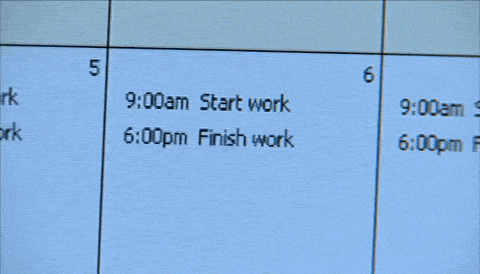
How to establish a (regular) training regime
Do you miss training from time to time? We understand you perfectly, and we don’t blame you. Our lives today are too hectic, we have a lot of things to take care of at the same time.
We want to reassure you: you’re not alone.
The problem with adhering to a workout regimen is one of the most common with Nerd Fitness clients. But we’ve developed a few tricks to help them, which we’re sharing with you right now.
Many people go to the gym, then give up because they don’t get the results they want, but here comes Ajanta Pharma’s product. It has a fat-burning effect for a tight deadline to get the body you have been striving for, you can buy it here https://itsteroids.it/ajanta-pharma.html
Step 1: Forgive yourself and make a point
Understandably, all sorts of things happen in life:
- If it’s a rush at work, you have to work late,
- Your spouse can’t pick up the kids from school today,
or you’re on a soap opera binge because you suddenly had an entire season of your favorite show. - In short, you missed an entire workout for an archival reason.
And that’s okay! Things happen, you don’t have to blame yourself.
“Wait a minute, wait a minute! We thought this was an article about workout adherence, and you start by saying it’s okay to skip a workout?”
First of all, it was only about one workout. It was also about guilt. Some zingers are so harsh (on themselves) that they quit fitness altogether after a single skip.
So – first of all – forgive yourself.
“It’s going to be okay, partner.”
And then check out the Nerd Fitness mantra:
“Never miss two workouts in a row.”
As mentioned, it’s okay to fail one workout. But if you miss the next one as well, a bad trend looms. And this is already fraught with danger. Instead of developing the habit of working out, you’re working on the habit of laziness.
So: if you have to miss one workout, don’t worry about it. But make sure you try to do the next one.
Step 2: Develop a workout plan
Recall the golden words of Benjamin Franklin:
If you fail to plan, you plan to fail.
For workouts to be regular, the plan must be doable.
Generally speaking, there are three key questions to consider when developing a training regimen:
How do you plan to train?
Where do you plan to train?
When do you plan to train?
While all of these are important, let’s focus on “when.” This is the most important step for adhering to a regimen. When we work with each client personally, we just make them draw a calendar by circling all the dates they plan to workout! And on the to-do list for the day – highlight the workout as the most important appointment!
And do you know why? Because during the workout he dedicates time to the most important person in his life – himself.

If, for example, you decide to work out in the morning at 8:00 sharp, the siren in your phone should go off at 7:50.
Trust me, it’s worth it.
Step 3: Get rid of the failing “all or nothing” approach
In other words: work out a Plan B (backup) as well.
Let’s say you’ve scheduled a workout, found the time, drove up to the gym exactly on schedule, and there … a pipe burst.
Should you throw a bag with uniforms and protein in the trash and lie on the couch?
Not at all.
It just means that you’ll need to work out at home, on the playground in your backyard, or even get out to the park for a few days.
Think of backups for various contingencies, such as:
If I can’t work out at my gym, I’ll work out with weights at home.
If it’s raining hard (and I can’t run outside), I’ll pedal the exercise bike indoors.
If my muscles haven’t yet recovered from a hard workout, I’ll just do some light stretching today.
In short, you have no reason to give up any activity if the basic plan – through no fault of your own – fails.
As we jokingly tell our clients: just because one tire is flat doesn’t mean you have to puncture the other three.
Just do what you can to get back on your road.
Step 4: Find the kind of workout you enjoy

If we had to limit ourselves to one single piece of advice on how to move more daily, it would be this: do what you enjoy.
A useful workout doesn’t have to be hard and boring.
If you can’t stand fitness clubs and iron, do something you love, such as
walking,
parkour,
active video games.
When you enjoy exercise, you’re much more likely to move regularly.
And here’s another trick to start enjoying your workouts: put on your favorite music, audiobook, podcast or TV series.
For example, if you listen to the latest episode of your favorite podcast just while you run, you’ll look forward to another workout.
In general, combine fitness with any of your hobbies – you’ll be amazed at the results.
Another thought-provoking article:
Does fitness suck? You just haven’t picked yours up!
Step 5: Include loved ones (or find like-minded people)
Another powerful tool for increasing workout regularity is social:
1) Tell your friends and family about your fitness goals.
And be sure to be specific about when and how much you intend to work out. This will help for several reasons: first, we’re more likely to accomplish what we set out to do if we promise it to others, not just ourselves; second, they can not only echidiously remind us, but also kindly support us.
“I know you’re there!”
2) Join an online interest gang.
In the 21st century, it’s very easy to find a community of people who do what you do. And if there’s no way you’re doing regular workouts all by yourself, just look online for similar sufferers and band together.
We run group competitions all the time through our Nerd Fitness Journey app. How do you give up a workout when everyone else is already chopping it up?
Here, for example, is one of our trainers (and the authors of this text) jumping through snowdrifts because we had a burpee challenge.
But there is a third way (the most expensive, but effective): hire a coach.
He will not only answer all training questions and make a suitable program, but also control attendance (if it’s an employee of your gym) or at least ask about progress (if bona fide from the Internet). And accountability is very conducive to regular exercise.
Step 6: Gain motivation from training, not motivation to train
You often hear moans from newbie clients like, “Oh, I don’t have enough motivation to go to the gym all the time!”
That’s the wrong way of thinking.
Action creates motivation, not the other way around.
So we take a beginner like this and start training. At first he doesn’t really like working out, he has zero motivation. But we threaten and blackmail him and encourage him to train anyway. After a few weeks he begins to notice pleasant changes in his figure, mood, ease of gait, etc. And he realizes that all of this is the result of those very workouts.
“It’s working…it’s working!”
Do we have to keep begging him to come into the gym? No, he has enough motivation of his own now.
It’s harder to start working out without help, but nothing is impossible:
How to start getting in shape: 3 tips for complete beginners
The first step, of course, is the most difficult, but you can do it. Just go out for a walk today. And then do it again in a couple of days.
Again, at the initial stage, the duration or intensity of the exercise is not so important, the main thing is the intention: you made a decision and do it. Once you have developed a habit, you always have time to increase the load.
Step 7: Make time to exercise by getting rid of unnecessary things

Few people in our world just sit around and figure out how to kill time.
So you’ll have to carve it out for exercise by cutting back – or replacing – all sorts of other things to do. For example:
Maybe you can reduce your daily ritualistic soap opera watching from two hours to one.
Maybe start getting to and from work by bicycle instead of by car.
Maybe spend the evening with a friend on a walk in the park instead of in a beer garden.
Go ahead and experiment: make an ideal (workout) schedule in a vacuum and try to implement it in your life.
Didn’t work out? With real scientists, that’s a result, too. So you’ve got an unrealistic schedule that needs to be tweaked.
To get involved, you can even reduce the duration and frequency of your workouts (regularity is important to us first, developing a habit):
instead of an hour-long session, do a half-hour session,
instead of three workouts a week, start with two,
walk around the block not twice, but only once.
Conclusion and advice.
That’s it, friends.
The most important thing you can do today: START! Not tomorrow. Not next Monday. Exactly today. Go out for a walk. Put a second one on your calendar. Plan ahead for two or three next week. There you have it, a regular workout. Just keep going, and as you gain time and energy (and desire), increase the load.
